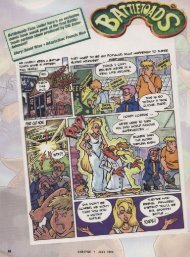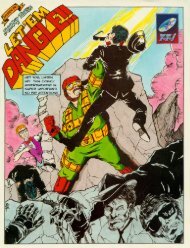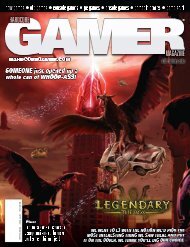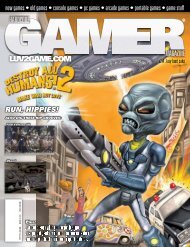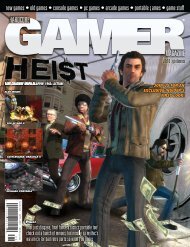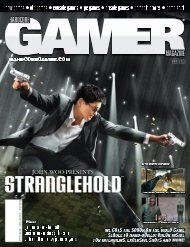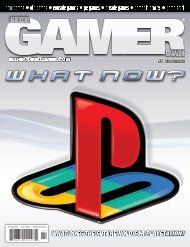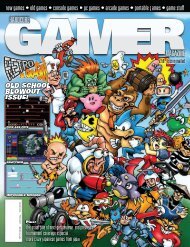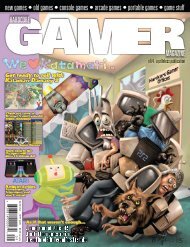4of 5 - Defunct Games
4of 5 - Defunct Games
4of 5 - Defunct Games
You also want an ePaper? Increase the reach of your titles
YUMPU automatically turns print PDFs into web optimized ePapers that Google loves.
Publisher: Sega<br />
Developer: Sonic Team<br />
Release Date: Q4 2006<br />
Genre(s): RPG<br />
Category: Wow, It’s Shiny<br />
# of Players: 1 - A Whole Lot<br />
This is another one of those imports that seemed like it was going to be so much cooler<br />
than it actually was. SD Gundam G Generation Portable was the rst PSP game to top<br />
the Japanese sales charts, and was widely reported to be an enhanced port of the 2000<br />
PlayStation title SD Gundam G Generation F. This is a big deal because G Gen F is far and<br />
away one of the best Gundam games, and is a great strategy game in its own right.<br />
In G Gen F, your goal was to build up a team of original pilots and mecha drawn from the<br />
entirety of the Gundam franchise. You acquired teams by essentially visiting a particular<br />
Gundam storyline to capture mecha and pilots while engaging in turn-based, grid-driven<br />
strategy warfare. Once you acquired a unit or its blueprint, you could mass produce it,<br />
customize it, merge it into a new unit, or just level it up. You had to be careful, though; once<br />
a unit was shot down, it and its pilot were gone for good, along with whatever investments you<br />
made in them.<br />
In broad strokes, all of this is true of G Gen Portable, but G Gen P still feels anemic compared<br />
to the original. G Gen F included an incredible variety of alternate play modes that are outright<br />
gone. The G Gen F roster included lots of obscure Gundam manga and side-stories to play with, but G<br />
Gen P only includes battles and units based on the various Gundam anime. G Gen P does add 17 new<br />
battles and a host of units based on the two recent Gundam SEED anime, but this doesn’t<br />
make up for everything else that’s been taken out.<br />
What’s worse is how G Gen P completely lobotomizes G Gen F’s legendary dif culty curve.<br />
You can unlock blueprints for many new units simply by seeing them in action, and you begin<br />
the game with G Gen F’s most powerful machine as a default unit. Instead of having to<br />
make sure you capture and sell lots of enemy units to acquire more capital to improve your<br />
army with, there’s a new “Haro Ranking” mechanic that lets you acquire money simply by<br />
shooting down enemies. G Gen P ultimately doesn’t demand much strategy at all. You just<br />
need enough patience to clear each map.<br />
Perhaps worst of all, though, is G Gen P’s game-killing load time glitch. Sometimes, when you’re<br />
loading a large amount of new data, such as after nishing a level or when ending a turn, the loading<br />
process hangs. There’s no remedy besides resetting and starting over from wherever you last saved<br />
your progress. There’s no way to know when it’ll happen. Knowing that you could lose all of your<br />
progress at any moment makes playing SD Gundam G Generation Portable seem profoundly pointless.<br />
No. Get a copy of the original G<br />
Generation F instead. There aren’t any<br />
SEED units, but everything else about it is<br />
so much better.<br />
2of 5<br />
Review by Lynxara<br />
74_JAPAN_GUNDAM G GENERATION PORTABLE HARDCORE GAMER MAGAZINE_VOLUME 2_ISSUE 5_CALL CHUCK<br />
Review by Sardius<br />
The unlockable bonus material is entirely in<br />
Japanese, but gameplay itself is unaffected by the<br />
language barrier. Buy this now!<br />
HARDCORE GAMER MAGAZINE_VOLUME 2_ISSUE 5_CALL CHUCK<br />
Publisher: Nintendo<br />
Developer: Nintendo<br />
Release Date: August 3, 2006<br />
(Rhythm Tengoku)<br />
Genre(s): Rhythm<br />
Category: .59<br />
# of players: 1<br />
Why isn’t rhythm-based gameplay more popular? The genre’s inherent learning curve may have something to do with it. As fun<br />
as they may be, games like Guitar Hero and Dance Dance Revolution are hostile toward beginners, since a player has to master<br />
their unconventional control schemes before either title can be enjoyed. This problem dates back to the genre’s earliest days, as<br />
even a simple rhythm title like Parappa the Rapper required memorizing the PlayStation controller’s button con guration, which<br />
was an immediate impasse for many casual gamers.<br />
You don’t need to buy an expensive and cumbersome controller to play Rhythm Tengoku, however. Rhythm Tengoku doesn’t<br />
require you to memorize button placements, nor is it dif cult enough to scare off casual players. If you’re able to press your<br />
Game Boy Advance’s A button in time to a simple beat, you’re well on the way to mastering the bulk of Rhythm<br />
Tengoku’s minigames.<br />
Rhythm Tengoku (or “Rhythm Heaven”) was developed by the same team behind Nintendo’s WarioWare series, which<br />
will become very obvious within the rst few minutes of play. Everything from Rhythm Tengoku’s art style to its<br />
frenzied gameplay screams Wario, and several sound samples are bound to be familiar to WarioWare fans.<br />
Unlike WarioWare, however, Rhythm Tengoku’s forty-eight minigames are all rhythm-based. Simple cues in<br />
the background music tell you when to press buttons in order to complete a variety of consistently weird<br />
objectives. One game has you bouncing a rabbit across an army of sea creatures, for instance, while<br />
another features a man in space batting a stream of baseballs along to a salsa beat.<br />
As abstract as these objectives may sound, the gameplay never feels unnatural, as your innate sense of<br />
rhythm will guide your button presses more than on-screen cues. Many levels can be played just as well<br />
with your eyes closed, in fact. This is a good thing, as Rhythm Tengoku has a habit of dimming or distorting<br />
the screen during certain challenges, forcing you to rely entirely upon the musical beat and your own<br />
sense of rhythm to succeed.<br />
Boss stages come in the form of “remixes”: longer levels that combine elements from previous<br />
challenges with rapid objective switch-ups and tempo changes. While challenging, these<br />
remixes — and all the other stages — are fairly easy to pass on your rst or second try.<br />
Obtaining all of Rhythm Tengoku’s achievements and unlockables, however, requires<br />
exceptional or even perfect play in all levels. This is a dif cult process that will<br />
challenge even the most hardened rhythm game veterans.<br />
WarioWare’s simple, re ex-based gameplay works wonderfully in the context<br />
of a rhythm game, and the end result is something that can be<br />
enjoyed by both the casual and the hardcore. This is the best por-<br />
table rhythm title since Osu! Tatakae! Ouendan, and you’d<br />
better damn well import it if you know what’s<br />
good for you.<br />
5of 5<br />
RHYTHM TENGOKU_JAPAN_75



